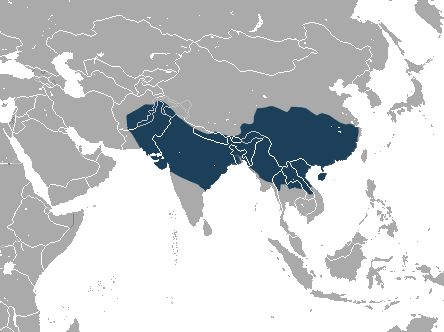
Habitat and Geography
The Rhesus monkey is a very commonly-used research animal, and they can be found being raised in captivity worldwide. However, the species originated in southern China and Tibet. Although still found in these areas, their numbers have been slashed by rapid urban growth and human population booms. Today, the Rhesus monkey can be most commonly found living in the wild in western Afghanistan, throughout India, and in parts of northern Thailand (Seinfeld, 2005). They can be found living comfortably anywhere in this extremely large range below about a 4,000-meter altitude. They have even been known to live naturally in fairly close proximity to humans (Lang, 2005).
Their habitats vary greatly across this wide geographic range. A
very high level of adaptability enables them to thrive in just about
any environment. Some populations live in the flatlands of
Afghanistan that can approach nearly desert-like conditions.
Conversely, some have been found to inhabit the Himalayan mountain
range in Pakistan and India at altitudes of up to 4,000 meters.
Some estimates say that nearly half of the population of the Rhesus monkey in northern India live in urban areas and depend heavily on humans for food. They have been known to live comfortably within cities, railway stations, and temples and come in frequent contact with humans at close range (Lang, 2005).
Although comfortable living amongst humans, the majority of the
wild populations of Rhesus monkeys live in isolation of human
contact. Again, the ability to adapt to many environments allows
them to survive at within a wide temperature range. In the
mountainous regions temperatures range from about -4 degrees to
around 104 degrees Fahrenheit. Rain levels can vary from about 2
feet per year to well over 5 feet. In the flatlands of India, the
temperature can peak at upwards of 118 degrees (Lang, 2005)!

Even though the Rhesus monkey is more than capable of surviving in these environments, not all of their habitats are quite so extreme. In the tropical ranges of China, temperatures remain in the very mild range of 72 to 82 degrees and rains often enough to remain comfortable (Lang, 2005).
In this geographical range, the monkeys can be found living in the rocky habitat of the Himalayas, swampy wet regions, dry flatlands of India, tropical forests in sea level China, and still in the urban setting amongst human populations (Lang, 2005).
As you can see, Macaca mulatta is an incredibly adaptable and
versatile species that is adept at surviving in a wide range of
habitats. They have adjusted well to the human population expansion,
and have even begun to live amongst them within urban areas. It is
safe to say that the Rhesus monkey would thrive in the vast majority
of environments across the globe.
Return home or learn about the Rhesus monkey species classification.
